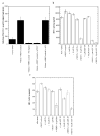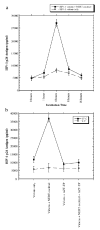Inhibition of endogenous reverse transcription of human and nonhuman primate lentiviruses: potential for development of lentivirucides
- PMID: 16859727
- PMCID: PMC1626530
- DOI: 10.1016/j.virol.2006.06.014
Inhibition of endogenous reverse transcription of human and nonhuman primate lentiviruses: potential for development of lentivirucides
Abstract
In the current study, we extended our previous works on natural endogenous reverse transcription (NERT) and further examined its potential as a virucide molecular target in sexual transmission of primate lentiviruses. HIV-1 and SIV virions were pretreated with select nucleoside (NRTIs) and nonnucleoside RT inhibitors (NNRTIs), either alone or in combination with NERT-stimulating substances. The effects of these antiretrovirals on virion inactivation were analyzed in human T cell lines and primary cell cultures. Pretreatment of HIV-1 virions with physiologic NERT-stimulants and 3'-azido-3'-deoxythymidine 5'-triphosphate (AZT-TP) or nevirapine potently inactivated cell-free HIV-1 virions and resulted in strong inhibition of the viral infectivity. Pretreatment of chimeric SHIV-RT virions with NERT-stimulating cocktail and select antiretrovirals also resulted in virion inactivation and inhibition of viral infectivity in T cell lines. Our findings demonstrate the potential clinical utility of approaches based on inhibiting NERT in sexual transmission of HIV-1, through the development of effective anti-HIV-1 microbicides, such as NRTIs and NNRTIs.
Figures



Similar articles
-
Pharmacodynamic studies (PD) of didanosine (ddI) alone and in combination with azidothymidine (AZT) in human T-cells; a stochastic biochemical approach to antiretroviral nucleoside drug combination in inhibiting HIV-reverse transcriptase (RT).In Vivo. 2000 May-Jun;14(3):377-88. In Vivo. 2000. PMID: 10904870
-
In vitro characterization of a simian immunodeficiency virus-human immunodeficiency virus (HIV) chimera expressing HIV type 1 reverse transcriptase to study antiviral resistance in pigtail macaques.J Virol. 2004 Dec;78(24):13553-61. doi: 10.1128/JVI.78.24.13553-13561.2004. J Virol. 2004. PMID: 15564466 Free PMC article.
-
Chimeric HIV-1 and feline immunodeficiency virus reverse transcriptases: critical role of the p51 subunit in the structural integrity of heterodimeric lentiviral DNA polymerases.J Mol Biol. 1998 May 15;278(4):757-65. doi: 10.1006/jmbi.1998.1739. J Mol Biol. 1998. PMID: 9614940
-
Natural endogenous reverse transcription of HIV-1.J Reprod Immunol. 1998 Dec;41(1-2):255-60. doi: 10.1016/s0165-0378(98)00062-x. J Reprod Immunol. 1998. PMID: 10213314 Review.
-
Sites, mechanism of action and lack of reversibility of primate lentivirus inactivation by preferential covalent modification of virion internal proteins.Curr Mol Med. 2003 May;3(3):265-72. doi: 10.2174/1566524033479889. Curr Mol Med. 2003. PMID: 12699362 Review.
Cited by
-
Anti HIV-1 virucidal activity of polyamide nucleic acid-membrane transducing peptide conjugates targeted to primer binding site of HIV-1 genome.Virology. 2007 Jun 20;363(1):91-103. doi: 10.1016/j.virol.2007.01.016. Epub 2007 Feb 21. Virology. 2007. PMID: 17320140 Free PMC article.
-
Drug 9AA reactivates p21/Waf1 and Inhibits HIV-1 progeny formation.Virol J. 2008 Mar 18;5:41. doi: 10.1186/1743-422X-5-41. Virol J. 2008. PMID: 18348731 Free PMC article.
-
Mechanism of Deoxyguanosine Diphosphate Insertion by Human DNA Polymerase β.Biochemistry. 2021 Feb 9;60(5):373-380. doi: 10.1021/acs.biochem.0c00847. Epub 2021 Jan 21. Biochemistry. 2021. PMID: 33475337 Free PMC article.
References
-
- Baltimore D. Viral RNA-dependent DNA polymerase. Nature. 1970;226:1209–1211. - PubMed
-
- Balzarini J, DeClercq E, Uberla K. SIV/HIV-1 hybrid virus expressing the reverse transcriptase gene of HIV-1 remains sensitive to HIV-1-specific reverse transcriptase inhibitors after passage in rhesus macaques. J AIDS. 1997;15:1–4. - PubMed
-
- Balzarini J, Naesens L, Verbeken E, Laga M, Van Damme L, Parniak M, Van Mellaert L, Anne J, De Clercq E. Preclinical studies on thiocarboxanilide UC-781 as a virucidal agent. AIDS. 1998;12:1129–1138. - PubMed
Publication types
MeSH terms
Substances
Grants and funding
LinkOut - more resources
Full Text Sources

